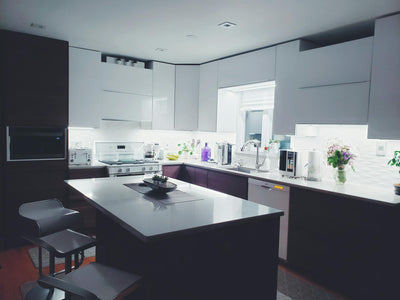Understanding Refrigerator Drawers and Built-In Freezers
When you're in the market for refrigeration solutions, you might find yourself comparing the merits of built-in freezers versus refrigerator drawers. Both have their unique benefits and can cater to specific needs and spaces.
Exploring Different Refrigeration Options
Refrigeration is not one-size-fits-all. Whether you're a culinary enthusiast or simply someone who values convenience and efficiency in the kitchen, you might consider various options like column refrigerator freezers, upright freezers, or undercounter beverage coolers. Each type of refrigeration appliance offers unique features that might align with your lifestyle and space constraints.
The Functionality of Built-In Freezers
Built-in freezers are designed to blend seamlessly with your kitchen cabinetry, providing a sleek and custom look. These units are typically taller than they are wide and can offer ample storage space for frozen goods. They're ideal for those who like to stock up on frozen foods or who need extra space for storing large items like turkeys or bulk purchases.
Built-in freezers often come with features such as adjustable shelves, bins, and in-door storage to help keep items organized. For those with specific needs, comparing a built-in freezer to a kegerator or countertop freezer can highlight the right choice for your household.
The Purpose of Refrigerator Drawers
Refrigerator drawers, on the other hand, are a versatile refrigeration solution that can be installed independently or alongside your main refrigerator. They're generally installed under the counter and are perfect for small kitchens or as an addition to a larger kitchen where extra cold storage is needed.
These drawers offer easy access to frequently used items and can be a great way to separate different types of foods, like produce or beverages. They can also be a smart choice for specialized storage needs, such as undercounter beverage coolers or for those looking for convenience in spaces like a home bar or entertainment area.
When deciding between a built-in freezer and refrigerator drawers, consider your space, storage needs, and how you intend to use the appliance. Whether you're a professional chef requiring a meat refrigerator or a homeowner in need of an efficient apartment size refrigerator, there's a refrigeration option tailored to your requirements.
Capacity and Storage
When you're evaluating the best refrigeration solution for your home, understanding the capacity and storage options of a built-in freezer compared to a refrigerator drawer is essential. Each has distinct advantages that cater to different storage needs and kitchen sizes.
Comparing Storage Space
Built-in freezers are often designed to provide ample space for frozen goods. They typically offer larger capacities than refrigerator drawers, making them ideal for storing bulk items or larger quantities of food. On the other hand, refrigerator drawers are more compact and are designed for easy access to frequently used items.
Here is a comparison of average storage capacities for built-in freezers and refrigerator drawers:
| Appliance Type | Average Capacity (cubic feet) |
|---|---|
| Built-in Freezer | 15 - 20 |
| Refrigerator Drawer | 2 - 5 |
Organization and Accessibility
When it comes to organization, built-in freezers may include shelves, bins, and baskets that help you categorize and locate items easily. They often feature vertical storage, which can be ideal for stacking and sorting large quantities of food.
In contrast, refrigerator drawers offer horizontal storage that can be pulled out, providing easy access to items without having to bend down or move things around. This can be particularly convenient for items you reach for on a daily basis.
Organizational features may include:
- Built-in Freezer: Adjustable shelves, door bins, ice makers
- Refrigerator Drawer: Dividers, sliding compartments
If you're considering which option will best fit your lifestyle, think about your buying habits and the types of items you need to store. For those who purchase in bulk or have large families, a built-in freezer may be more suitable. However, if you value convenience and easy access for daily use items, refrigerator drawers might be the better fit.
For more detailed comparisons between different types of refrigeration units, check out our articles on column refrigerator freezer vs. mini fridge freezer or shallow depth refrigerator vs. upright freezer. These resources can provide further insights into choosing the right appliance for your specific needs.
Design and Installation
When choosing between a built-in freezer and a refrigerator drawer, the design and installation aspects are as crucial as their functionality. These features not only affect the aesthetic appeal of your kitchen but also the usability and the workflow within the space.
Built-In Freezer Features
Built-in freezers are designed to seamlessly blend with your kitchen cabinetry, offering a sleek and uniform look. They are typically installed at eye level, which allows easy access and visibility to the contents. Many built-in freezers come with customizable panels that can match your kitchen's design theme.
| Feature | Description |
|---|---|
| Installation | Custom fit into cabinetry |
| Appearance | Streamlined with panel-ready options |
| Accessibility | Eye-level placement for convenience |
Built-in freezers might require a more involved installation process, as they must fit specific dimensions and often require a custom cabinet front. These freezers are ideal for those who prefer a kitchen with a cohesive design and are willing to invest in a long-term solution. Explore the differences in design aspects between a built-in freezer vs. a refrigerator drawer to better understand which suits your kitchen's layout.
Refrigerator Drawer Features
Refrigerator drawers offer a unique solution for additional refrigeration needs, often installed under counter spaces or within kitchen islands. They are perfect for storing beverages, produce, or snacks at an accessible height, especially in a kitchen where children are present.
| Feature | Description |
|---|---|
| Installation | Undercounter or in islands |
| Appearance | Discreet and convenient |
| Accessibility | Easy access for all family members |
The installation of refrigerator drawers is generally less complicated than that of built-in freezers, as they can be slid into existing cabinetry without the need for custom panels. However, it's crucial to ensure proper ventilation for optimal performance. If you're interested in comparing undercounter options, consider reading about undercounter beverage coolers vs. upright refrigerators.
Integration into Kitchen Layout
Integrating either a built-in freezer or refrigerator drawers into your kitchen layout depends on your storage needs, design preferences, and kitchen size. Built-in freezers are a good choice for families needing ample frozen storage, whereas refrigerator drawers offer additional refrigeration space without taking up much room.
| Kitchen Feature | Built-In Freezer | Refrigerator Drawer |
|---|---|---|
| Space Requirements | Requires ample vertical space | Fits into base cabinetry |
| Design Consistency | Custom panel options for a uniform look | Blends easily with undercounter design |
| Accessibility | Ideal for organized frozen storage | Convenient for frequent access items |
To decide which option best fits within your kitchen's design, consider how each will complement the existing layout. For instance, a built-in freezer may be more suitable for a large kitchen renovation, while refrigerator drawers can be a practical addition to a small or already established kitchen. For those with specific layout needs, comparing narrow refrigerators to wider built-in options might provide additional insights.
Energy Efficiency
When comparing a built-in freezer to a refrigerator drawer, energy efficiency is a vital factor to consider. Energy consumption and environmental impact are key aspects that can influence your decision, especially if you're environmentally conscious or looking to save on electricity costs.
Energy Consumption
Both built-in freezers and refrigerator drawers have varying levels of energy consumption based on their size, insulation, and technology. Generally, newer models are more energy-efficient due to advancements in technology and stricter energy regulations.
Below is a table that provides a general comparison of average energy consumption between the two types of appliances. These values can vary based on specific models and usage patterns:
| Appliance Type | Average Energy Consumption (kWh/year) |
|---|---|
| Built-in Freezer | 400-600 |
| Refrigerator Drawer | 300-500 |
You should look for energy ratings and consider energy-saving features such as automatic defrost and LED lighting when making your choice. Additionally, proper maintenance can help ensure that your appliance runs efficiently. For more insights on energy-efficient options, you might want to read about energy efficient refrigerator vs. mini fridge freezer.
Environmental Impact
The environmental impact of refrigeration appliances is not limited to their energy consumption. It also includes the type of refrigerants they use, which can contribute to global warming if not properly managed.
Modern refrigerators and freezers are more likely to use refrigerants with a lower global warming potential (GWP), which is better for the environment. Additionally, the manufacturing process, materials used, and end-of-life disposal of the appliance also contribute to its overall environmental footprint.
When considering the environmental impact, it's important to look for appliances that have the Energy Star label, which indicates higher energy efficiency and a lower environmental impact. You can also consider factors such as recyclability of materials and the manufacturer's sustainability practices.
By considering both energy consumption and environmental impact, you can make an informed decision that aligns with your values and needs. Whether you opt for a built-in freezer or refrigerator drawer, choosing an appliance that minimizes energy usage and has a lower environmental impact will contribute to a more sustainable home. For more information on comparing different refrigeration solutions, check out the article on column refrigerator freezer vs. mini fridge freezer or explore other options such as undercounter beverage cooler vs. upright refrigerator.
Maintenance and Durability
When deciding between a built-in freezer and a refrigerator drawer, it's important to consider the aspects of maintenance and durability. These factors affect not only the lifespan of your appliance but also the time and effort you'll invest in upkeep.
Cleaning and Upkeep
Maintaining the cleanliness and functionality of your refrigeration unit is essential. For built-in freezers, the upkeep generally involves periodic defrosting, depending on the model, and cleaning the interior shelves and compartments. Since these units are often larger, cleaning might be more time-consuming but less frequent.
| Maintenance Task | Built-In Freezer | Refrigerator Drawer |
|---|---|---|
| Defrosting | Periodic (manual or automatic) | Rarely needed |
| Cleaning Shelves | Less frequent, more volume | More frequent, less volume |
| Interior Wipe-down | Spacious, less accessible corners | Compact, easier to reach areas |
Refrigerator drawers, on the other hand, are typically used more frequently, possibly requiring more regular cleaning. However, their smaller size and easier access can make the process quicker and less labor-intensive. They may also feature removable drawers and compartments for convenient washing.
Both types of units will benefit from the use of mild detergents and avoiding abrasive materials to prolong the life of the surfaces. You should also regularly inspect and clean the door seals to ensure efficient operation. For more on maintaining different types of refrigeration units, you may want to read about countertop refrigerator vs. freestanding drawer freezer.
Longevity and Reliability
The longevity and reliability of your refrigeration unit are dependent on the quality of construction and how well you maintain it. Built-in freezers are often designed with long-term use in mind, made with durable materials meant to withstand years of operation.
| Appliance Type | Expected Lifespan (Years) | Reliability Factors |
|---|---|---|
| Built-In Freezer | 15-20 | Compressor quality, door seal integrity |
| Refrigerator Drawer | 10-15 | Drawer mechanism, electronic controls |
Refractor drawers are convenient, but the frequent opening and closing may put more wear on the drawer mechanisms compared to the traditional swing door of a built-in freezer. Additionally, as technology advances, refrigerator drawers may incorporate more electronic components, which can affect their longevity.
Both types will last longer with proper care, including routine cleaning and servicing. It's important to follow the manufacturer's guidelines for maintenance and to address any issues promptly to avoid further complications. For insights into the reliability of different configurations, consider exploring beer fridge vs. freezer drawer or all freezer refrigerator vs. wine chiller.
In summary, your choice between a built-in freezer and a refrigerator drawer will have implications for maintenance and durability. Assess your willingness to perform regular cleaning, your need for reliability, and how these factors align with your lifestyle before making a decision.
Cost Considerations
When weighing the options between a built-in freezer and refrigerator drawers, you should consider both the initial price tag and the ongoing operational expenses. These factors play a significant role in your decision-making process, especially when budget constraints are a concern.
Initial Investment
The upfront cost for built-in freezers and refrigerator drawers can vary widely based on size, features, and design. Built-in freezers typically require a larger initial investment due to their size and integration into the kitchen cabinetry. In contrast, refrigerator drawers may offer a more cost-effective solution for added refrigeration without the need for extensive kitchen modifications.
To help you understand the typical price ranges, here’s a comparison table of average costs:
| Appliance Type | Average Cost Range |
|---|---|
| Built-In Freezer | $2,000 - $7,000 |
| Refrigerator Drawer | $1,500 - $4,000 |
It's important to keep in mind that these prices can fluctuate based on the complexity of the installation and any additional customizations. When planning your kitchen layout or considering a remodel, take a look at our articles on column refrigerator freezer vs. mini fridge freezer and shallow depth refrigerator vs. upright freezer for a broader understanding of installation considerations.
Operational Costs
Operational costs include energy consumption, maintenance, and potential repairs over the lifespan of the appliance. Energy efficiency is a key factor in determining ongoing expenses, as a more efficient appliance will cost less to operate. Built-in freezers and refrigerator drawers both come with energy ratings that can guide you in choosing an appliance that aligns with your sustainability goals and budget.
Maintenance expenses should also be taken into account. Built-in freezers typically have longer service intervals but may be costlier to repair due to their integrated nature. Refrigerator drawers are generally easier to access for cleaning and service, potentially offering savings on maintenance.
Here’s a breakdown of average annual operational costs based on energy consumption:
| Appliance Type | Average Annual Energy Cost |
|---|---|
| Built-In Freezer | $50 - $100 |
| Refrigerator Drawer | $30 - $60 |
For more insights on energy efficiency and its impact on costs, you might find our article on energy efficient refrigerator vs. mini fridge freezer helpful.
By thoroughly evaluating both the initial and ongoing costs, you can make an informed decision that suits not only your refrigeration needs but also your financial considerations. Whether you opt for the expansive storage of a built-in freezer or the convenient access of refrigerator drawers, understanding the full scope of expenses will ensure you find the best fit for your space and lifestyle.
Suitability for Different Spaces
Choosing between a built-in freezer and refrigerator drawers comes down to the specific needs of your space and how you plan to use them. Each option has environments where it excels, offering convenience, efficiency, and integration for various settings.
Ideal Settings for Built-In Freezers
Built-in freezers are best suited for spaces where preserving food in bulk is a priority. They seamlessly fit into kitchen cabinetry, providing a sleek and custom look that's perfect for homeowners who desire a high-end aesthetic.
| Location | Suitability |
|---|---|
| Home Kitchen | High |
| Apartment | Moderate |
| Condo | High |
| Garage | Moderate to High |
| Basement | High |
| Cabin | Moderate to High |
| Townhouse | High |
These freezers are also ideal for large families or those who entertain often, as they provide ample space for frozen goods. For those living in areas with limited grocery access or who prefer to shop infrequently, a built-in freezer can be an excellent investment. Furthermore, chefs and food enthusiasts might find the consistent temperature control and potential for custom organization systems advantageous. Check out comparisons like garage freezer vs. medium size refrigerator for more insights on the suitability of built-in freezers in different environments.
Practical Applications of Refrigerator Drawers
Refrigerator drawers, on the other hand, offer a versatile refrigeration solution for a variety of spaces and needs. They are perfect for spaces where convenience and accessibility are key, such as in a family kitchen or an office where snacks and beverages need to be readily available.
| Location | Suitability |
|---|---|
| Kitchen Island | High |
| Undercounter in Home Bar | High |
| Office | High |
| Entertainment Areas | High |
| Secondary Storage in Kitchen | High |
These drawers can serve as dedicated storage for fresh produce or drinks, making them a great addition to a chef's kitchen or for those who love to host parties. Their compact size also makes them a practical choice for smaller living spaces like apartments or tiny homes where space is at a premium. For more information on how refrigerator drawers compare to other compact options, see mini fridge with freezer vs. refrigerator drawer.
When evaluating the best option for your living space, consider factors such as the intended use, available space, and design preferences. Whether you opt for the generous storage of a built-in freezer or the convenient access of refrigerator drawers, ensure that your choice aligns with your lifestyle and the characteristics of your home.
Get Your Upgrade or New Addition at Fridge.com
Shop the world's best brands at Fridge.com.
Whether you're searching for your perfect fridge, freezer, wine fridge, beer fridge, ice maker, or kegerator, we have what you need.
We also have tons of awesome articles about kitchen stuff and home news. Enhance your home, garage, backyard, patio, and office with the coolest essentials. With every necessary type of residential refrigerator or freezer in our collection, we've got you covered.
Elevate your game and shop now at Fridge.com!






